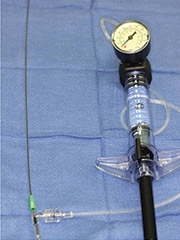Endoscopic Airway Dilation
 Balloon catheter and pressure gauge used for airway dilation
A mild and soft airway narrowing in the areas of the subglottis (subglottic stenosis) or trachea (tracheal stenosis) may be treated endoscopically. This type of narrowing may be dilated (opened) using a small, angioplasty-type balloon (like those used to treat some heart conditions) which is inflated in the airway to compress or stretch the stenosis. The balloon is inflated for only a brief period in the airway. It is also useful for a stenosis that is re-forming after open airway surgery, such as laryngotracheal reconstruction (LTR).
Balloon catheter and pressure gauge used for airway dilation
A mild and soft airway narrowing in the areas of the subglottis (subglottic stenosis) or trachea (tracheal stenosis) may be treated endoscopically. This type of narrowing may be dilated (opened) using a small, angioplasty-type balloon (like those used to treat some heart conditions) which is inflated in the airway to compress or stretch the stenosis. The balloon is inflated for only a brief period in the airway. It is also useful for a stenosis that is re-forming after open airway surgery, such as laryngotracheal reconstruction (LTR).
Sometimes, balloon dilation is combined with endoscopic incision or removal of scar tissue to treat the stenosis. This scar tissue removal is done using a microlaryngeal sickle knife, cup forceps, or a powered instrument called a microdebrider. A small amount of a steroid called triamcinolone or Kenalog® may be placed on the surface of, or injected into, scar tissue in the airway. This keeps the scar tissue from reforming.
Balloon catheter dilation of a patient’s airway which was narrowed due to subglottic stenosis.
During an endoscopic airway dilation, your child is in the operating room for approximately 30 to 40 minutes. Your child may be hospitalized overnight for observation if the surgeon has any concerns about airway swelling or bleeding. Your child will require a follow-up microlaryngoscopy and bronchoscopy a couple of weeks or months after the airway dilation to make sure that the area of stenosis does not become narrowed again. If this happens, a surgeon may need to repeat the procedure.
